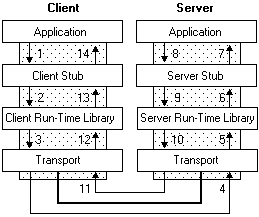
The RPC tools make it appear to users as though a client directly calls a procedure located in a remote server program. The client and server each have their own address spaces; that is, each has its own memory resource that is allocated to data used by the procedure. The following figure illustrates the RPC architecture.

As the illustration shows, the client application calls a local stub procedure instead of the actual code implementing the procedure. Stubs are compiled and linked with the client application. Instead of containing the actual code that implements the remote procedure, the client stub code:
The server performs the following steps to call the remote procedure:
The remote procedure then runs, possibly generating output parameters and a return value. When the remote procedure is done, a similar sequence of steps returns the data to the client:
The client completes the process by accepting the data over the network and returning it to the calling function:
For Microsoft Windows 3.x, Windows 95, and Windows NT, the run-time libraries are provided in two parts: an import library, which is linked with the application and the RPC run-time library, which is implemented as a dynamic-link library (DLL).
The server application contains calls to the server run-time library functions which register the server's interface and allow the server to accept remote procedure calls. The server application also contains the application-specific remote procedures that are called by the client applications.